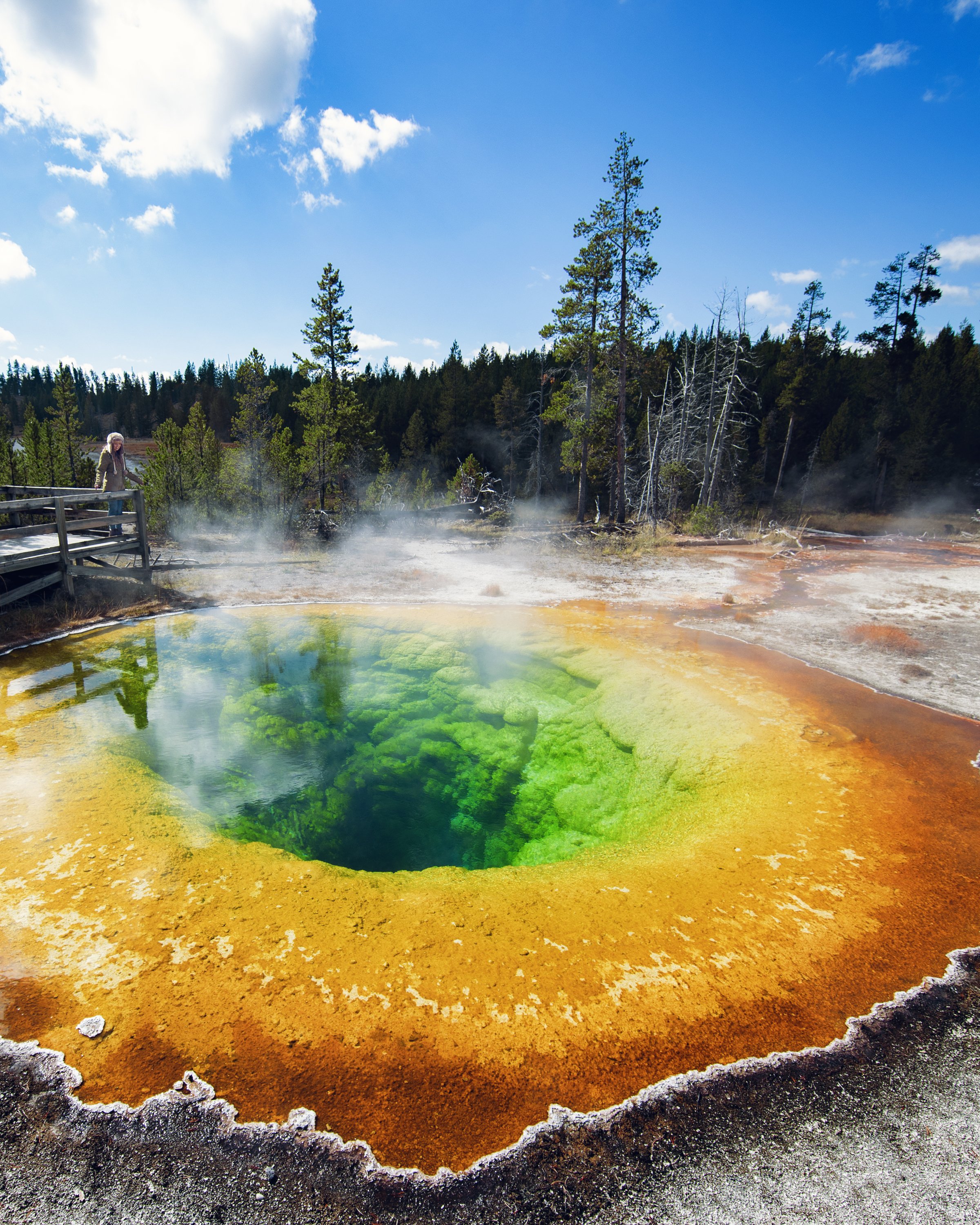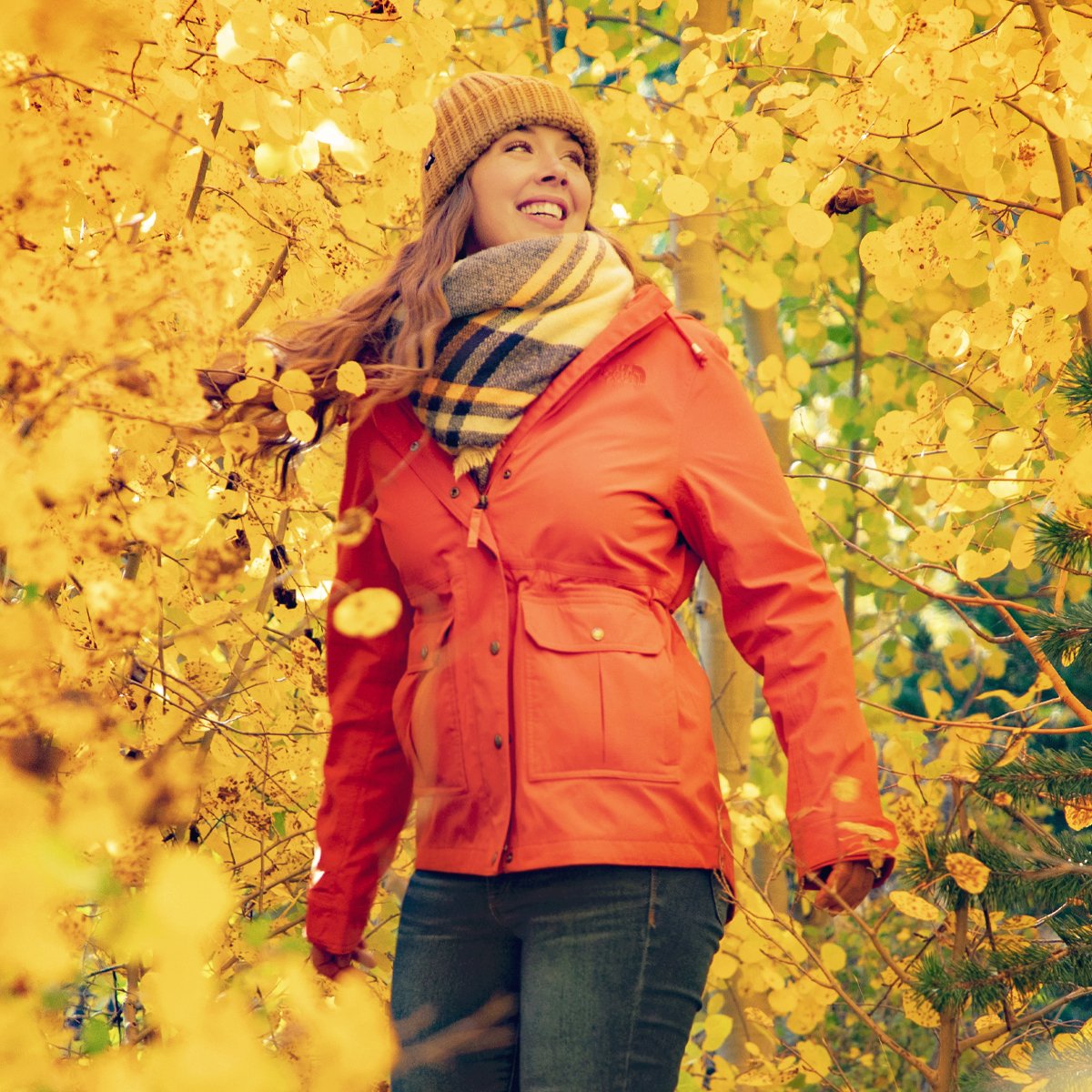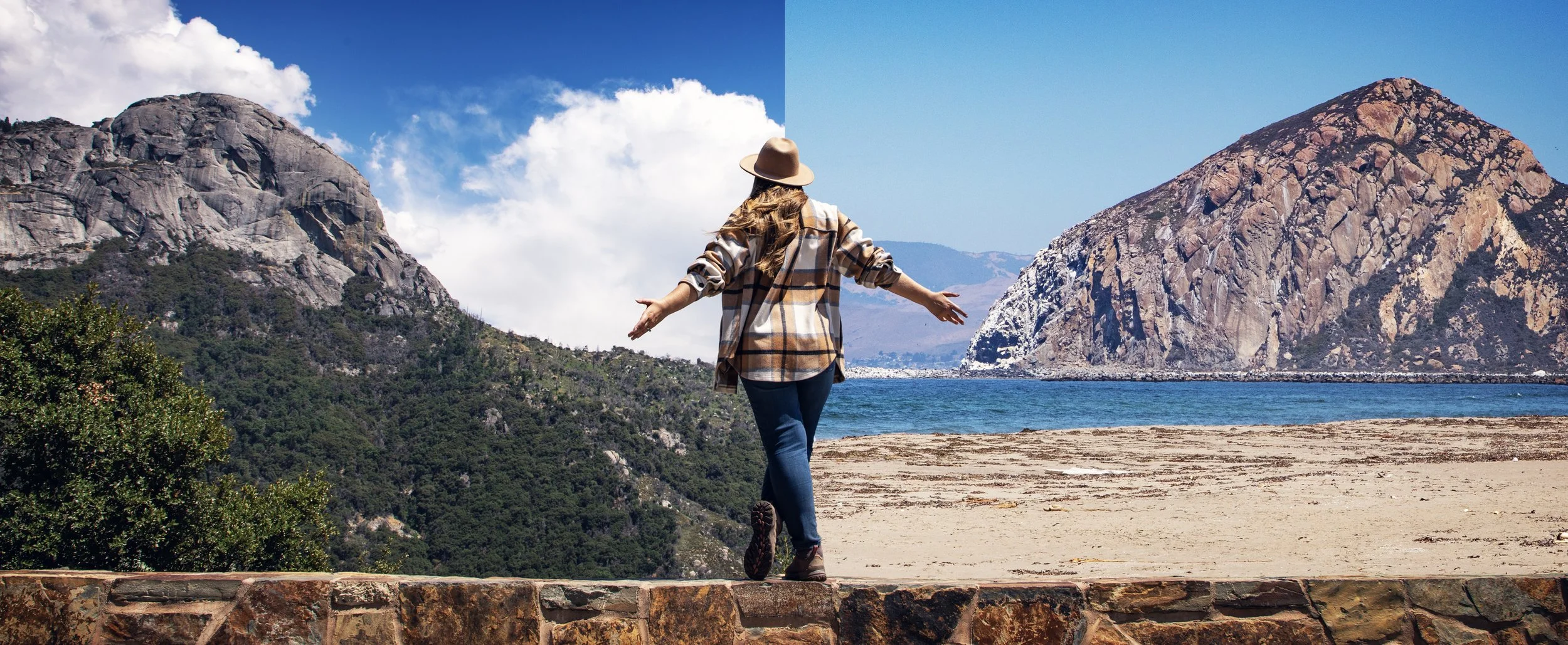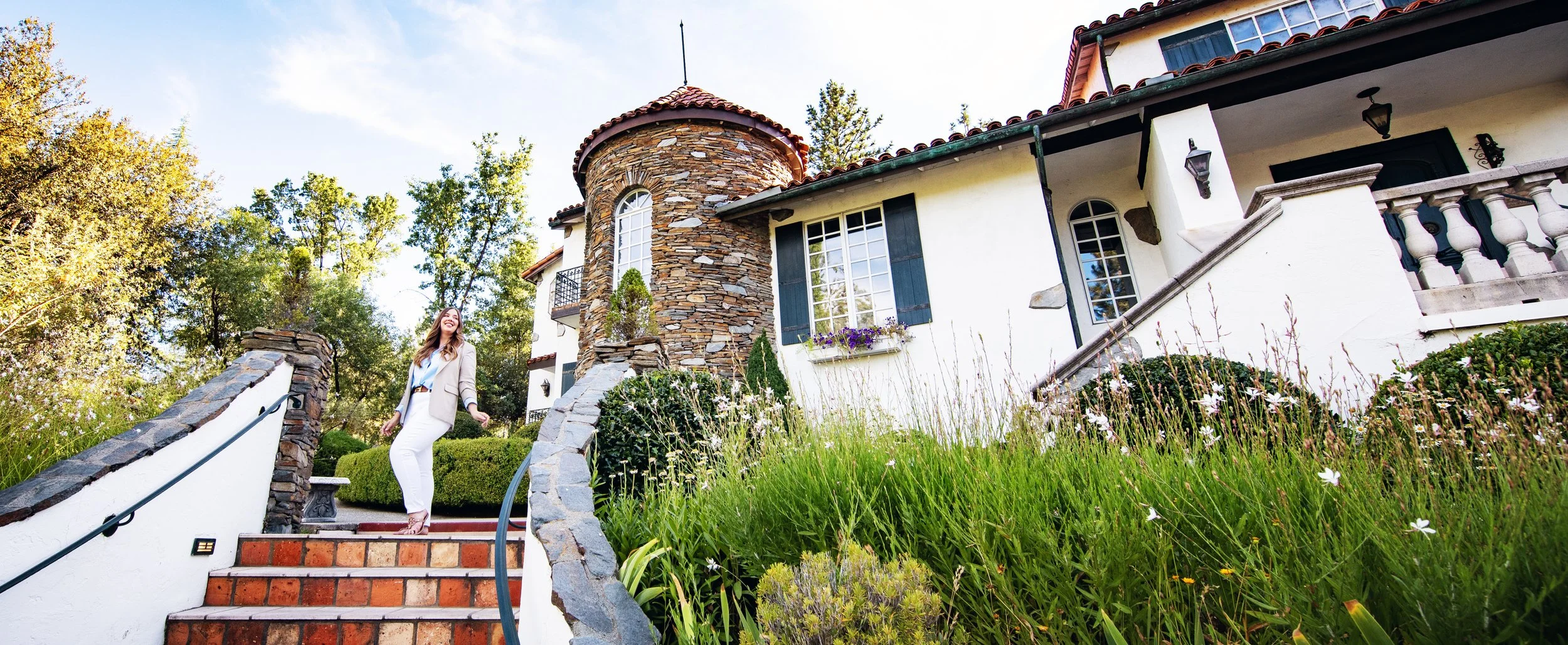First-Timer's Guide to Yellowstone: Explore the Wonders of the First National Park
Hi friends and happy National Parks Week! To celebrate America's national park system, I’m sharing a comprehensive first-timer’s guide to Yellowstone National Park. Join me for an unforgettable journey through this mesmerizing wonderland of geothermal wonders, majestic wildlife, and breathtaking landscapes. Yellowstone promises an experience like no other. So buckle up and let's dive into this visitor's guide to exploring the many wonders of Yellowstone National Park.
Old Faithful steaming at sunrise in Yellowstone’s Upper Geyser Basin
Location
Gateway to the Wild
Yellowstone National Park spans an awe-inspiring 3,472 square miles of pristine wilderness. Most of the park sits inside the state of Wyoming, but areas extend into both Montana and Idaho as well. Its unique location atop the Yellowstone Caldera (one of the largest volcanic systems in the world) sets the stage for an unparalleled showcase of geothermal activity, including some of the most diverse and impressive geysers, hot springs, and bubbling mud pots on earth.
Lower Yellowstone Falls & the Grand Canyon of the Yellowstone
Grand Loop Road & Park Entrances
Accessing Yellowstone’s Many Wonders
For first-time visitors to Yellowstone National Park, the Grand Loop Road is your key to exploring the park's stunning natural wonders. This 142-mile scenic drive connects the major attractions within the park, including geysers, waterfalls, and wildlife viewing areas. The road is divided into upper and lower loops, offering a comprehensive tour of Yellowstone's diverse landscapes. When planning your visit, note that sections of the Grand Loop can be closed at different times of the year.
As you’re planning your trip, be aware that the park has five entrances: the North Entrance near Gardiner, Montana; the Northeast Entrance close to Silver Gate and Cooke City, Montana; the East Entrance near Cody, Wyoming; the South Entrance by Grand Teton National Park and Jackson, Wyoming; and the West Entrance near West Yellowstone, Montana. Each entrance provides access to different sections of the park, so choose your starting point based on your desired itinerary and enjoy your journey through one of America's most iconic national parks!
Beauty Pool in Yellowstone’s Upper Geyser Basin
History & Geology
Unraveling the Mysteries
Established as our nation’s first national park on March 1st, 1872, Yellowstone was founded to ensure public access, enjoyment of nature, and conservation of wilderness for generations to come. Yellowstone not only holds the distinction of being America’s first national park, but it is also the world's first national park. Beneath the ground’s surface here lies a geological tapestry shaped by thousands of years of volcanic activity, culminating in the one-of-a-kind breathtaking landscapes we see today. Members of the Washburn Expedition of 1870 are credited with the first recorded visitors to this area, however the land was long revered by Native Americans and a total of 26 tribes have ancestral connections to Yellowstone.
Old Faithful erupts near Old Faithful Inn in Yellowstone National Park
Morning Glory Pool in Yellowstone’s Upper Geyser Basin
Old Faithful & Upper Geyser Basin
Nature's Spectacular Show
No visit to Yellowstone National Park is complete without witnessing the iconic Old Faithful geyser. Named for its reliable eruptions, this geyser erupts on average nearly 20 times a day, shooting anywhere from 100 to 185 feet in the air for 1 to 5 minutes. Just steps away from the Old Faithful Inn, this world-famous Yellowstone geyser has has been captivating visitors with its majestic beauty since the park’s inception. Surrounding Old Faithful, the Upper Geyser Basin boasts the highest concentration of geysers in the world. A total of five large geysers in this basin (including Old Faithful) are predicted by the Park Rangers and you can often see the daily schedule at the Old Faithful Visitor Education Center, as well as each geyser’s location. The Upper Geyser Basin Trail can be hiked mid-April through mid-November when roads are open to traffic. The trail is also accessible by snow coach during much of the Winter.
For details on this area, including highlights like Morning Glory Pool, Castle Geyser, and the Daisy Geyser Group, see my full Old Faithful & Upper Geyser Basin blog post.
White Dome Geyser erupting along Yellowstone’s Firehole Lake Drive
Black Warrior Lake & Hot Lake boardwalk in Yellowstone
Firehole Spring in Yellowstone National Park
Firehole Lake Drive
Journey Through a Geothermal Wonderland
On your park visit, make sure to embark on the picturesque drive along Firehole Lake Drive. Yellowstone is home to nearly half of our world’s geysers, and this 3-mile one-way paved road just off Yellowstone’s Grand Loop Road, circles through a spectacular section of the Lower Geyser Basin. To reach this area, drive about 7 miles north of the Old Faithful interchange, or 9 miles south of Madison Junction along Grand Loop Road. Firehole Lake Drive passes geysers, hot lakes, hot springs and even a unique hot cascade, but the incredible features found along this drive don’t often get as much attention as their nearby neighbors...meaning this is a great area to escape some of the large crowds often found inside the park. Highlights here include Great Fountain Geyser which often erupts twice a day and shoots water anywhere from 100 to 200 feet high. White Dome has grown over hundreds of years into a massive white cone shape that’s almost sealed off at the top, and eruptions here are frequent, happening every 20-30 minutes. One of my favorite spots here is a stunning cluster of geysers and geothermal activity found scattered around Hot Lake, Black Warrior Lake and Firehole Lake. On chilly days, you can both see and feel the hot steam rise up around you as you walk along the wooden boardwalk trail.
For details on this area, see my full Firehole Lake Drive blog post.
Clepsydra Geyser & Fountain Geyser along Fountain Paint Pot Trail
Fountain Paint Pots in Yellowstone National Park
Bacterial Mats along Fountain Paint Pot Trail in Yellowstone
Fountain Paint Pot Trail
Exploring Nature's Palette
Step onto the Fountain Paint Pot Trail to immerse yourself in a kaleidoscope of colors and textures. This trail follows a half-mile boardwalk loop located along Grand Loop Road within the Lower Geyser Basin. The area is unique in that it showcases all four types of hydrothermal features found inside the park, including geysers, hot springs, mud pots, and fumaroles. In fact, a thermophile organism which revolutionized DNA processes (Thermus Aquaticus) was discovered here. Along the boardwalk marvel at the namesake, “Fountain Paint Pot,” made up of clay minerals and silica particles. The colors here vary throughout the year, as does the thickness of these mudpots. In Spring they can appear thin and watery, but by late Summer the mud can be so thick that bubbles burst up to the trail railing. Over a dozen named features are sprinkled along the path here, including Leather Pool, which boasts a beautiful dark surface, and Silex Spring, which is colored with piercing icy blue hues.
For more information on this surreal landscape, see my full Fountain Paint Pot Trail blog post.
Mammoth Hot Springs in Yellowstone National Park
Angel Terrace along Upper Terrace Drive at Mammoth Hot Springs
Liberty Cap with Palette Spring and Devils Thumb in the distance
Mammoth Hot Springs
Nature's Sculptural Masterpiece
Journey north to Mammoth Hot Springs, where terraces of travertine cascades create an otherworldly landscape reminiscent of a frozen waterfall. When entering the park from the north entrance, Mammoth Hot Springs sits on a hill along Grand Loop Road, near Gardiner, Montana. This area is adjacent to Fort Yellowstone and the Mammoth Hot Springs Historic District. The features here were created over thousands of years as hot water cooled and deposited calcium carbonate. Comprised of an upper and lower terrace that are connected by a boardwalk, this spot has nearly 20 hydrothermal features to enjoy. Upper Terrace Drive is a scenic 1.5 mile loop you can explore in your vehicle or by hiking. Highlights include Angel Terrace, Orange Spring Mound, White Elephant Back Terrace, and Prospect Terrace. Mammoth Hot Springs Trail connects the upper and lower terrace by several hundred steps...so if you have issues with multiple stair cases, consider driving to the upper and lower boardwalks separately. Lower Terrace highlights include Liberty Cap, Palette Spring, and Opal Spring. The Mammoth area often sees great elk activity during the rut (or elk mating season), which peaks in late September or early October.
For details on this area, see my full Mammoth Hot Springs blog post.
West Thumb Geyser Basin boardwalk at sunrise
The West Thumb Geyser Basin along Yellowstone Lake
Black Pool at West Thumb Geyser Basin in Yellowstone National Park
West Thumb Geyser Basin
Where Geothermal Land Meets Water
Located along the shores of Yellowstone Lake is one of my favorite sunrise spots. West Thumb Geyser Basin offers a unique blend of geothermal activity and alpine beauty. Framed by the Absaroka Range to the east, Yellowstone Lake is often considered the heart of Yellowstone. West Thumb is the large western bay of Yellowstone Lake that resembles a “thumb”. A figure-eight trail here stretches half a mile around the outer boardwalk loop and a quarter mile around the inner loop. Nearly two dozen named features can be found along the upper boardwalk group including Seismograph Pool, Bluebell Pool, Blue Funnel Spring, and Perforated Pool. Notable features along the lower boardwalk group include Lakeshore Geyser, Fishing Cone, and Black Pool.
See my full West Thumb Geyser Basin blog post for more details on this magical spot.
Potts Hot Spring Geyser Basin at the edge of Yellowstone Lake
Potts Hot Spring Geyser Basin
An Ever-Changing Landscape
Located just up the road from West Thumb, the Potts Hot Spring Geyser Basin is home to over 40 unique geysers. Until 1970, the main road along Yellowstone Lake’s West Thumb passed along this basin on the shoreside, and a boardwalk provided up-close views. The road was rerouted and the boardwalk removed due to the hydrothermal activity in the area in the early 1970s, and now only a small pull off and short path are accessible, which lead to a scenic overlook spot. From here you can still see the Mercurial Group and small parts of the Beach Group.
Lower Yellowstone Falls crashes into Grand Canyon of the Yellowstone
Brink of the Upper Falls in Yellowstone National Park
Red Rock Point Trail in Grand Canyon of the Yellowstone
Grand Canyon of the Yellowstone & Yellowstone Falls
Nature's Grandeur
No visit to Yellowstone is complete without marveling at the awe-inspiring Grand Canyon of the Yellowstone and its crown jewel, Yellowstone Falls. The Yellowstone river flows from Hayden Valley and plunges down 109 feet at Upper Yellowstone Falls, and then a quarter mile downstream, Lower Yellowstone Falls crashes down 308 feet. Here it then enters the Grand Canyon of the Yellowstone, which is nearly 25 miles long, up to 4,000 feet wide, and 1,200 feet deep. Artist Point is arguably one of the most spectacular straight on viewpoints of the Grand Canyon & Lower Yellowstone Falls, which is often considered the most photographed view in Yellowstone...the scenery here is unbelievable.
Stunning waterfall views here include Upper Falls View at Uncle Tom’s Point and the Brink of the Upper Falls. A mostly paved trail is less than 1/2 a mile round trip and leads to multiple overlooks, separated by just a few stairs. There’s also an often overlooked side path here leading downstream to views of Crystal Falls. The Brink of the Lower Falls Trail is a popular 0.7 mile out and back trail, and when weather permits, you can combine Brink of Lower Falls with North Rim Trail for a 2.3 mile hike.
For more details on this area, see my Grand Canyon of the Yellowstone & Yellowstone Falls blog post.
Midway Geyser Basin seen from Grand Prismatic Overlook
Grand Prismatic seen from Midway Geyser Basin boardwalk
Midway Geyser Basin boardwalk in Yellowstone National Park
Midway Geyser Basin & Grand Prismatic Spring
Brilliant Blues to Fiery Oranges & Vivid Greens
Journey to the heart of Midway Geyser Basin and behold the vibrant hues of Grand Prismatic Spring, the park's largest hot spring and a true marvel of nature's artistry. Midway Geyser Basin may be one of Yellowstone’s smaller geyser basins, but it is home to the largest hot spring in North America (the third largest in the world). Named for its striking rainbow colors, Grand Prismatic is nearly 370 feet in diameter and 120 feet deep. The NPS has created a beautiful boardwalk (just under one mile long), so you can enjoy this natural wonder up-close.
While Grand Prismatic is the star of the show at Midway Geyser Basin, Excelsior Geyser and Turquoise Pool are also notable features located just steps away. Once you’ve enjoyed the striking boardwalk views, consider taking the short but steep hike to the Grand Prismatic Overlook. Starting from the Fairy Falls Trailhead, you can reach one of the best (and most photographed) views of Grand Prismatic in just 1.5 miles out and back.
For details on this area see my complete Grand Prismatic Spring blog post.
Lamar Valley in Yellowstone National Park
American bison in Yellowstone’s Lamar Valley
Lamar Valley
North America’s Serengeti
Venture into the Lamar Valley, often referred to as the "Serengeti of North America," and prepare to be dazzled by an abundance of wildlife. Keep your eyes peeled for bison, pronghorn, elk, grizzly bears, and more roaming freely amidst the vast grasslands and meandering waterways. Located in the northeast section of Yellowstone, this area also provides the best opportunity to catch a glimpse of elusive wolves prowling through the tall grasses.
Bald eagle near Lamar Valley in Yellowstone National Park
Hayden Valley seen from Grizzly Overlook in Yellowstone
Hayden Valley
Wildlife Hotspot
Hayden Valley, situated along the east side of the Grand Loop north of Yellowstone Lake, is a serene and picturesque expanse that captivates visitors with its breathtaking scenery and abundant wildlife. This vast valley is encompassed by rolling hills, lush meadows, and the meandering Yellowstone River, creating a tranquil oasis for both visitors and the diverse range of wildlife that call it home. Visitors to Hayden Valley are often treated to sightings of bison herds grazing peacefully, majestic elk roaming the meadows, and grizzly bears foraging for food. The unique landscape and the vibrant ecosystem make Hayden Valley a must-see destination for nature enthusiasts and wildlife lovers seeking a glimpse of the untamed beauty of Yellowstone. There are multiple spots to pull off on the side of the highway, but one of the best vantage points is near the north end of the valley at Grizzly Overlook.
Bull elk bugling at Mammoth Hot Springs during rut season
Bison herd in Yellowstone’s Lamar Valley
Yellowstone Wildlife
Where, When, and How to View It
Nearly 300 species of birds, 16 species of fish, 5 species of amphibians, 6 species of reptiles, and 67 species of mammals call Yellowstone National Park home. From bald eagles and big horn sheep to bison and moose, every trip to Yellowstone is sure to be filled with wonderful wildlife. To maximize your chances of spotting these magnificent creatures, consider visiting during the early morning or late afternoon when animals are most active. Spring is arguably the best time of year to visit for wildlife. Bears are hungry following hibernation, and the snow remaining in the higher elevations drives wildlife to more visible areas of the park. However, no matter what season you decide to take a Yellowstone vacation, wildlife is sure to be present and within view. Make sure to bring binoculars and a telephoto lens for optimal viewing, and always maintain a safe distance to respect the animals' space.
Continental Divide during a snowstorm in Yellowstone National Park
More Yellowstone Highlights
Continental Divide: Stand atop the Continental Divide, where the waters part ways, flowing either to the Atlantic or Pacific Ocean.
Gibbon Falls: Located along the Gibbon River, Gibbon Falls is a magnificent 84-foot waterfall that showcases the natural beauty of Yellowstone National Park.
Lewis Falls: Tucked away in the woodlands, Lewis Falls plunges 30 feet over volcanic rocks, offering a tranquil and picturesque setting for visitors to enjoy.
Roosevelt Arch: The iconic entrance to Yellowstone, the Roosevelt Arch stands as a historic symbol of welcoming travelers to the wonders of America's first national park.
Norris Geyser Basin: A dynamic hydrothermal area, Norris Geyser Basin is home to a diverse range of geysers, hot springs, and fumaroles, captivating visitors with its geothermal features.
Sheepeater Cliff: Rising dramatically from the Gardner River, Sheepeater Cliff provides a glimpse into Yellowstone's geological past, formed by volcanic activity and erosion over thousands of years.
Red Rock Point in Grand Canyon of the Yellowstone
Know Before You Go
• Before your visit, I encourage you to learn about and take the Yellowstone Pledge. and please remember the Leave No Trace Principles on your visit. Always plan ahead and prepare, familiarizing yourself with the park regulations.
• Always check the NPS website for the most accurate and up-to-date park information, including weather/closures and park details.
• You may encounter posted restrictions by the NPS in some areas of the park. Depending the time of year, some locations can be closed due to active grizzly bears. Some trails may also require hiking in groups of four or more people to increase visitor safety and to dissuade wildlife from approaching.
• The only road generally open year-round to regular vehicles is from the North Entrance at Gardiner, Montana, through the park to Cooke City, Montana (via Tower Junction). Most park roads are closed to regular vehicles from early November to late-April, and are open to limited oversnow travel (commercially-guided snowmobiles and snowcoaches) from mid-December to mid-March. When open, people may enter/exit the park 24 hours a day, seven days a week.
• It’s incredibly important to stay on official trails & boardwalks, not only for your personal safety, but also to protect these fragile formations. Never touch or attempt to enter any hydrothermal areas as they can be extremely unstable and pose life threatening danger to anyone who ignores the park regulations here.
• Yellowstone is rich with wildlife, so please drive carefully. Never approach wildlife and never leave food unattended. Remember we are guests in their home. Always keep at least 100 yards from bears and wolves as well as 25 yards from bison, elk and all other wildlife. Carry bear spray in a readily accessible location and know how to use it.
• Smoking is prohibited in all of Yellowstone’s hydrothermal areas, and for their safety, pets are not allowed here.
• Toxic gases have been measured in some hydrothermal features...if you feel sick it’s important to leave the location immediately.
• Traffic-related accidents are the most common cause of injury and death in the park, so always drive cautiously and watch for animals. The speed limit in Yellowstone is 45 mph unless posted otherwise.
Top 10 Spots in Yellowstone
Old Faithful Geyser erupting in Yellowstone National Park
In Summary
Thanks so much for joining me this week for my First-Timer’s Guide to Yellowstone. For a virtual visit of my time in Yellowstone National Park, make sure to watch my Behind the Blog video located at the top of this post, or watch it on YouTube here. Until next week, I hope you find adventure and encouragement wherever you go.
Yellowstone’s Hayden Valley seen from Grizzly Overlook
If you enjoyed this post, you might also like…
About Me
I’m Dawn Marie, a travel and lifestyle blogger based out of Southern California. With in-depth articles, travel guides, and reviews on hotels & products, I seek to share my journeys to help you plan for your own. My adventures take me all over California, the western United States, and around the globe...and every Monday I post new content here, including a comprehensive blog post and YouTube video.
Search the Blog
Featured Posts
Etsy Shop













































Get a clear breakdown of the new 2026 U.S. National Park fees for residents and nonresidents, including updated entrance costs, annual pass changes, and what to expect at the gates. This guide covers Yosemite, Sequoia, Yellowstone, Grand Canyon, and other top parks, plus essential Flying Dawn Marie recommendations to help international travelers plan their national park trip with confidence.